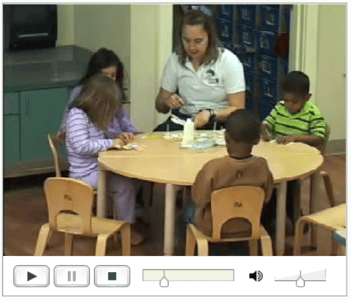
If you are a Pre-K Affiliate Trainer, you may be growing a little weary of the training video, “Making Butterflies.” It may surprise you to hear this, but as a staff trainer for Teachstone, “Making Butterflies” happens to be one of my favorite videos in the Pre-K CLASS Observation Training.
“WHAT?” you may have just asked your computer screen out loud!
Yes, it’s true. We trainers need a video like “Making Butterflies” in our trainer toolbox; it is a valuable experience for your participants, and it supports them in becoming objective, reliable CLASS observers. Here are three reasons why you too should embrace this video:
- It is your opportunity to support your trainees in becoming objective observers.
The best thing that happens in “Making Butterflies” is the emotional reaction that occurs as the participants view the video. This is your opportunity as a trainer to gather evidence using the CLASS lens versus your participants’ personal feelings/lenses about the teacher. When your trainees say something like, “She’s just sitting there and not doing anything,” you have a huge "in." Try supporting your trainees to transfer those emotions to the CLASS lens. I help by encouraging participants to find some specific language from the low range in Instructional Learning Formats. By substituting “She’s just sitting there...” with “...the teacher passively sits [at] the table monitoring the students and does not become involved in the activity or provide guidance for students’ expanded participation...” (Pg. 56 of your Pre-K CLASS Manual), you help participants not only use CLASS language, but become objective observers as well. - It helps participants become grounded in Negative Climate.
Participants are going to try to over-code (be too harsh) on the teacher. They will want to be harder on the teacher than the code actually reflects (surely this video is HIGH negative climate, they are thinking). If you have proactively trained Negative Climate during Day 1 (being sure you clarified not only what Negative Climate looks like in the low range, but also mid, and high), participants should discover during the coding process that there is no evidence of severe negativity and only mid-range evidence in the other indicators. This is so valuable as you guide your participants to become reliable CLASS observers. - It supports the participants’ understanding of Productivity, a dimension that often troubles trainees and new observers.
The strength present in this video is the dimension of Productivity. This can be a surprise to your participants, even if you have been proactive on Day 1 in clarifying the definition of the dimension. This video provides you a much-needed example of Productivity, and helps you clarify that the dimension does not measure the quality of instruction present, but rather were activities actually provided. In “Making Butterflies,” this teacher has all of the materials she needs at the table, and the students were provided with the activity of coloring a butterfly. This video gives you as the trainer an important opportunity to clarify that this may not be an activity the participants like, or even approve of, but it is considered high range Productivity.
I could write so much more about this video and the opportunities it provides trainers to support participants in becoming reliable observers. Check out my blog post, 6 Facilitation Tips for Challenging Training Videos, for more advice on facilitating difficult training videos. If it has been awhile since you’ve felt as though “Making Butterflies” was relevant, consider giving the video another go. Watch the video again with fresh eyes and mark up your manual with notes to support you in discussing the Master Code Justification with trainees. Perhaps training video two will become your new favorite too!

